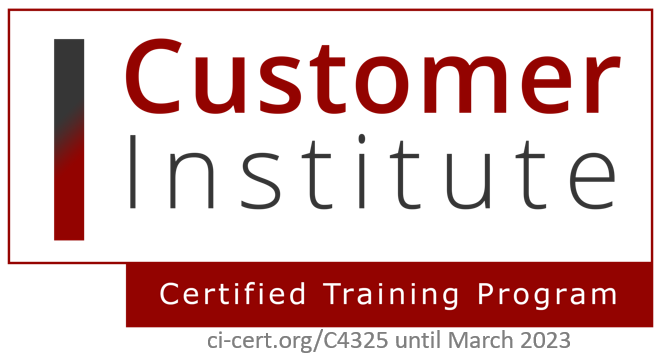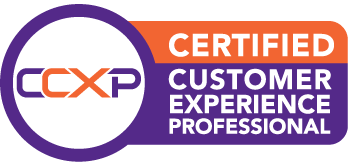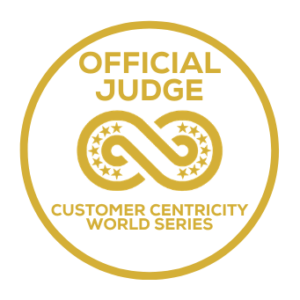Yellow Goldfish blog series
There should one ultimate driving metric in business (and life) and that’s Happiness. A Yellow Goldfish is anytime a business does a little extra to contribute to the happiness of its customers, employees, or society. Based on nearly 300 case studies, Yellow Goldfish, a book published by Stan Phelps and Rosaria Cirillo in September 2018, covers nine ways increasing happiness in business can drive growth, productivity and prosperity for everyone and it’s available for sales on Amazon & Kindle. Broken into three main sections, Yellow Goldfish will help you and your company understand WHY happiness in business matters, WHAT you can do to contribute to happiness (of customers, employees and society), and HOW to do so.
This post is part of a wider series with key insights from Yellow Goldfish. Find here the complete list of all this series’ posts that will be published every Monday and Wednesday from September 4th to September 18th (which marks Yellow Goldfish 1-year birthday).
“…the function of man is to live a certain kind of life, and this activity implies a rational principle, and the function of a good man is the good and noble performance of these, and if any action is well performed it is performed in accord with the appropriate excellence: if this is the case, then happiness turns out to be an activity of the soul in accordance with virtue.”
Why are we here? This is perhaps the greatest question of all. It has been pondered since the earliest days of human existence. It is our search for meaning in this world. Each of us is challenged with answering this question. Mark Twain once said that “the two most important days in our lives are the day we are born and the day we find out why.”
Should the “why” question apply to business as well? Why are companies in business? What or who is first priority? Where is its main focus? We believe there are five schools of thought or different management approaches that companies have adopted over past few decades:
“There is one and only one social responsibility of business and that is to engage in activities designed to increase profits.”
The 1.0 version of business is a shareholder first mindset. The sole purpose of a company is to maximize profits. The late economist Milton Friedman became its foremost proponent. He famously shared in his 1970 New York Times article that, “there is one and only one social responsibility of business–to use its resources and engage in activities designed to increase its profits so long as it stays within the rules of the game, which is to say, engages in open and free competition without deception or fraud.”
Profit was the coveted prize of business. The simple goal of business was to provide a return to shareholders. Focusing on external social responsibilities or lofty ideals would distract business from its sole purpose of maximizing profits.
Friedman believed that doing good was incompatible with doing well for your shareholders. And his views have been so pervasive into all types of businesses and peoples’ minds that is taking long time and effort to reverse this school of thoughts.
“Not so long ago companies assumed the purpose of a business is to make money. But that has proved as vacuous as saying the purpose of life is to eat…. The purpose of a business is to create and keep a customer.
The 2.0 version of business sees profit as an end result, not the goal. Companies should be dedicated to the business of getting and keeping customers. This focus places importance on the overall customer experience and managing ongoing relationships.
For Amazon customer centricity is the focus of their mission: “We seek to be Earth’s most customer-centric company.” Founder Jeff Bezos puts customers first and profit second: “We’re not competitor obsessed, we’re customer obsessed. We start with the customer and we work backwards…”
As early as 1954, Peter Drucker made a similar argument for a customer-first focus in his classic book, Management, when he wrote, “There is only one valid definition of business purpose: to create a satisfied customer…. It is the customer who determines what a business is… The customer is the foundation of a business and keeps it in existence.”
“Employees First, Customers Second is a management approach. It is a philosophy, a set of ideas, a way of looking at strategy and competitive advantage.”
The 3.0 version of business places employees first and culture at the forefront. It’s rooted in understanding where value is created in an organization. It’s created in the last two feet of a transaction, the space between the employee and the customer. Former HCL Technologies CEO Vineet Nayar calls these 24 inches the “value zone.” Nayar made employees the priority at HCL, putting employees first, customers second, management third, and shareholders last. He believed front line employees were the true custodians of the brand and drivers of customer loyalty. Nayar wanted to shift the focus from the “WHAT” of what HCL offered, to the “HOW” of delivering value.
A focus on employees first is based on the idea that culture trumps strategy in an organization.
“People don’t buy what you do or how you do it, they buy why you do it.”
The 4.0 version of business places purpose first. Companies that have a strong, defined purpose find that it drives employee engagement, connects with customers, and fuels the bottom line. John Kotter and James Heskett demonstrated in their book Corporate Culture & Performance that purposeful, value-driven companies outperform their counterparts in stock price by a factor of 12.
Purpose relates to your “Why” as a business. It should permeate everything you do. “Purpose should impact every aspect of the firm,” says Raj Sisodia, author of Conscious Capitalism.
Embracing purpose can become a driver of employee engagement. Daniel Pink touched on the importance of purpose in his book Drive. Pink said there are three things that motivate people: autonomy, mastery, and purpose. He believes that purpose is perhaps the greatest of the three, because a strong purpose allows you to overcome obstacles and persevere toward a goal.
The diatribe between these 4 schools of thoughts seems to Stan and I like the old millennial debates about whether the Earth it’s flat or round, or what is at the center of the solar system—the sun or the earth.
In my role as CX Advisor and CXPA Authorized Trainer to prepare CCXP (Certified Customer Experience Professional), I’m constantly asked “What comes first? Customers or Employees? Purpose or Profit?”
It’s like asking “What’s the most important part of our body? The heart, the brain or the lungs?” The first thing you learn during a First Aid Course is that you need all three and if one of them stops soon the other two do too.
Just like the solar system and just like our body, a business is a system, a complex system, which needs all of its parts to function well! And when it comes to both our body and our life and business, there is something extra to just breathing for oxygen or being in business for profit.
“Profit for a company is like oxygen for a person. If you don’t have enough of it, you are out of the game. But if you think your life is about breathing, you’re really missing something.”
We believe that we are at the beginning of a wide spread realization that there is a version 5.0 of business which sees happiness at the center of what we do: happiness for the customers that we serve, happiness of the employees within the organization, and happiness at a societal level, happiness for the next generation. When happiness is at the center and everything else rotates with purpose around it, profit, prosperity, and growth will follow as a result.
Happiness is something final and self-sufficient, and is the end of action. Everything that we choose, we choose for the sake of something else—except happiness.”
Happiness relates to our “Why” as human beings and to our common goal as a living specie. About 2,500 years ago, Aristotle pointed out that if we apply “why” to any question, at the end we find that everything we do has to do with wanting to be and feel happier.
Happiness makes us thrive, fulfill our potential, achieve more, and live longer. The relationship between success and happiness is reciprocal: we need to be happy to perform and be successful; and when we are happy, not only we are more successful, but our immune system is stronger.
Happiness is the ultimate WHY, the most sustainable competitive advantage and the ultimate currency in the Purpose Economy. It offers a competitive advantage because we buy, work, and live to pursue and attain happiness; because we buy more, work better and more effectively, and live longer and healthier lives when we are happy. The search for happiness drives the choices that we make due to the chemical wiring of the brain, which craves Dopamine, Oxytocin, Serotonin and Endorphins (the DOSE of chemicals that makes us happy). We will actively search for and choose for again experiences (hence companies) that have given us our needed DOSE of Happiness.
Happiness is the new “ultimate currency”, as Tal Ben-Shahar calls it in Happier. He says, “Through evaluating how happy something makes us, we have a common currency that enables us to compare seemingly unrelated experiences.”
Happiness is the new competitive advantage because happy customers and happy employees drive healthy and sustainable growth—even in time of crisis. Why? Happiness matters in business along three dimensions:
- 1. Employees: Happy employees have the highest return on investment (ROI), because they:
- are more productive, creative, and innovative.
- buy their company’s products or services.
- have lower sickness, absenteeism, and turnover rates—thereby reducing bottom-line expenses.
- advocate for and praise the company to friends and family.
- provide valuable feedback for improvement because they care more about their company.
- deliver the best service to customers because they are happy themselves.
- 2. Customers: Happy Customers are the most profitable because they:
- renew/repurchase and remain customers over the long term.
- buy more and are willing to pay a premium price.
- are more likely to forgive an experience hiccup and have lower cost to serve.
- They promote the brand to friends and family.
- give you their most valuable asset—TIME—by providing valuable feedback for improvement, writing reviews, and engaging in your communities and forums with useful content and support for other customers.
- live longer and are more successful: they thrive, and they buy more/longer (whether experiences, products, or services), hence they ultimately have higher Lifetime Customer Value.
- 3. Society/Community: Happy citizens bring substantial benefits for society as a whole.
The article “Happiness and Psychological Well-Being: Building Human Capital to Benefit Individuals and Society” on The Solutions Journal summaries well all the benefits. Happy citizens:
-
-
- are healthy people.
- live longer and enjoy a greater quality of life.
- function at a higher level, utilizing their personal strengths, skills, and abilities to contribute to their own well-being as well as that of others and society.
- are more likely to be compassionate and, therefore, to contribute to the moral fiber of society in diversely beneficial ways.
- are less prone to experience depression and, if they do, tend to manage it better and more quickly. They are less likely to experience anxiety, stress, or anger. As a result, happy people engage in fewer acts of violence or antisocial behaviours.
- enjoy stronger and more-lasting relationships, thus facilitating society’s social capital.
-
Overall, happy people contribute to society in economic, social, moral, spiritual, and psychological terms. Compared to unhappy or depressed people, the happier ones are less of a burden to health services, social welfare agencies, and police and justice systems and so are less of a burden to the economy.
Happiness matters to us all on all dimensions and building greater levels of individual happiness leads to a more healthy, wealthy, peaceful and happy functioning of society as a whole.
Why wouldn’t we all want to have and work towards such an outcome?
In the next posts of this series, we will share the WHAT and HOW companies can – and, in our opinion, have the responsibility to – contribute to all these 3 dimensions. Stay tuned!
This post is part of a wider series with key insights from Yellow Goldfish. Find here the complete list of all this series’ posts that will be published every Monday and Wednesday from September 4th to September 18th (which marks Yellow Goldfish 1-year birthday).
- Why Happiness in business? – From Yellow Goldfish Overview Section
- Why Yellow Goldfish? – From Yellow Goldfish Overview Section
- Uncovering H.A.P.P.I.N.E.S.S. in business – From Yellow Goldfish What Section – The Types
- Brief Overview of companies and examples covered in Yellow Goldfish – From Yellow Goldfish What & How Section
- Drive Happiness G.R.O.W.T.H. in Six Stages – From Yellow Goldfish How Section
- Yellow Goldfish Top Five Takeaways
Follow Rosaria Cirillo on Linkedin & wownowexp Instagram or sign up below to be notified as soon as a new blog post is published.
* Sharing is happiness. If our message resonates with you, please help us share it and let’s start building together the world we wish to live in. Thank you! #YellowGoldfish #HappinessDrivenGrowth
** If you would like to know more about how to pursue Happiness Driven Growth in your company or would like us to deliver an engaging talk about it at your event, get in touch or simply follow Rosaria Cirillo on LinkedIn & Instagram to receive her inspirational DOSE of Happiness.
*** Did you already enjoy reading Yellow Goldfish and want to help us inspire more persons? Helps us spread the word by sharing the quote that most resonated with you and by posting a picture of you with our book on Twitter, Instagram and/or LinkedIn using hashtags:
#YellowGoldfish
#YGBITW (Yellow Goldfish Book In The World)
#YellowGoldfishBook
#YellowGoldfishQuote
Yellow Goldfish book has been published on September 2018 and is the result of collecting and analyzing nearly 300 cases and identifying the common threads. It covers nine ways increasing happiness in business can drive growth, productivity and prosperity for everyone and it’s available for sales on Amazon. We hope it can help more companies understand WHY happiness in business matters, WHAT they can do to contribute to happiness of customers, employees and society, and HOW to do so.
If you would like to know more about Yellow Goldfish:

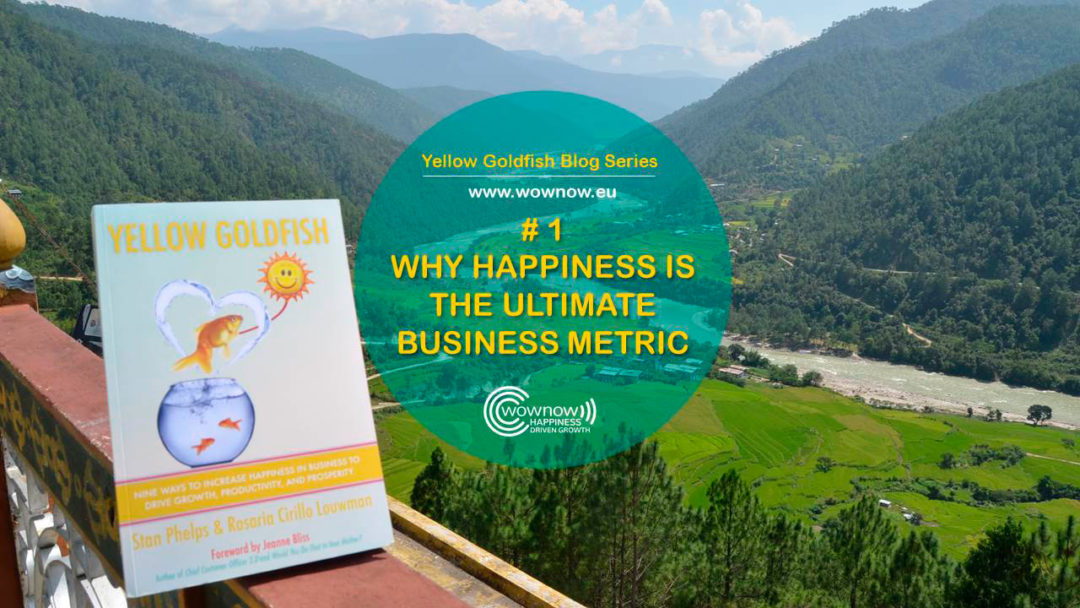

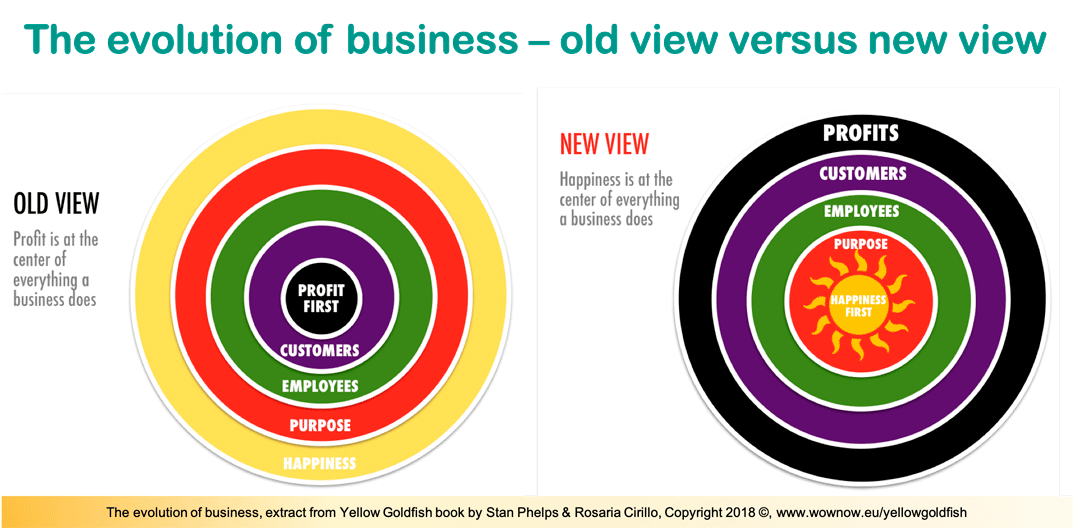

 A (little Italian) sunshine of energy, enthusiasm, and passion, with a mission to bring more happiness in the world one interaction at the time, the business world being my chosen playground!
I inspire and empower conscious leaders to nurture their happiness (moving from depleting to enriching emotions) and to move from depleting to enriching experiences, choosing, designing, and delivering WOW life-enriching interactions that contribute to everyone’s HAPPINESS, so they can achieve business and personal prosperity, making happiness their competitive advantage
A (little Italian) sunshine of energy, enthusiasm, and passion, with a mission to bring more happiness in the world one interaction at the time, the business world being my chosen playground!
I inspire and empower conscious leaders to nurture their happiness (moving from depleting to enriching emotions) and to move from depleting to enriching experiences, choosing, designing, and delivering WOW life-enriching interactions that contribute to everyone’s HAPPINESS, so they can achieve business and personal prosperity, making happiness their competitive advantage 